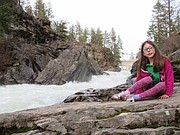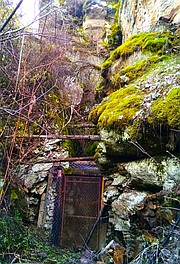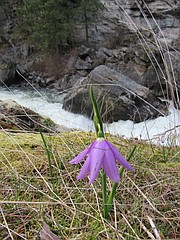Mysterious, majestic Q'emlin Park
I was visiting with Grandma Margaret and watching the chickadees land on her porch when I suddenly had the idea to ask her about the wooden mining claim post I had recently found while exploring the edges of Q’emiln Park.
I’d seen the weathered post from afar, my attention drawn to the rocks piled around the base. When I kneeled next to the post I could barely discern the words “No. 2 Golden Mint Mine”.
As soon as I thought of it, I knew she was the right person to ask. She had grown up in Post Falls and when my wife Karen was young, Grandma Margaret had owned the land where Templin’s Resort now stands, just upstream of the dam.
Some of my wife’s fondest childhood memories are of swimming under the branches of the weeping willow that grew on the edge of the river, or of swimming in the river under the full moon with her grandmother.
That afternoon Grandma Margaret told me a tale from her youth that sent me searching the corners of Q’emiln Park for the remnants of a mine worked by a man the townsfolk called “Diamond Dick.”
According to Grandma Margaret, Diamond Dick had a mine on the south flanks of the Spokane River near the falls. He came to town only occasionally, to buy supplies and drink at the bar. He would tell stories about the diamonds he was unearthing in his mine, trying to get people to invest so that he could continue digging. The money must have run out at some point because nobody saw Diamond Dick for some time, though when he was seen again he seemed to be flush with money. He again disappeared into the hills outside town and was thought to be working the mine once more.
Grandma Margaret didn’t know what happened to Diamond Dick, but many years later the city of Post Falls dynamited the entrance to the mine after some Boy Scouts found the mine shaft flooded and crumbling.
Grandma Margaret told me about the rocks she and her sister had collected from the entrance of the mine, well before the city blasted the shaft closed. The rocks looked as if they were full of rubies.
And some latent treasure hunter part of my brain was ignited.
I spent months crisscrossing the park whenever I had the chance. I searched the cliffs above Upper and Lower Fifth Canyons and walked the shoreline downstream past the dam as far as I could go.
I eventually found the remnants of the mine, unexpectedly, after scrambling up a rock and almost setting my hand down on a three-point deer shed. I did a little dance for joy , then looked up to see the busted timbers and ratted fencing of the closed off mine. I had found it.
I stopped off at the Post Falls Museum several weeks later to ask if they had any record of the mine, or whether they had the chunk of rock from the mine, which Grandma Margaret thought her sister had given to the museum.
The folks at the museum that day helped me look through archived newspapers until we found an article about when the city blasted the mine shaft closed. They knew nothing about the rock collected from the mineshaft, but the gentleman working the counter that day instead re-ignited the treasure hunter in me. He told me about the legend that Butch Cassidy had actually survived the infamous shootout in Bolivia and relocated to Spokane, where he had family, to work as a machinist. Apparently, as the legend goes, on his way to Spokane, Butch Cassidy hid gold under a tree, next to a creek between Coeur d’Alene and Spokane, on the wagon road that followed the southern shore of the river.
My thoughts immediately went to the old wagon road that runs through Q’emiln park, and the seasonal creeks that flow into the Spokane River.
I’ve never really pursued this legend, though it is fairly well-known. But still, I can’t help but look under every tree I walk by when I’m in the park, hoping to see something shiny poking out of the dirt.
Though I haven’t found any gold or rubies at Q’emiln, I have found wealth of a different sort.
I learned to rock climb on the cliffs at Q’emiln. I’m teaching my children to climb there as well. I consider these walls my home crags, as do many others. I often race off to the park after work on a nice day to climb to the well-established routes that range from a beginner’s level to very experienced.
The park also offers great opportunities for a quick family hike. Without much effort you can get away from the crowds you encounter in the parking lot, even in the midst of the summer.
Last winter my daughters and I hiked around the park, taking photographs of ice features, and watched a moose saunter underneath the climbing walls. I have watched a golden eagle circling on the wind currents over the cliffs above the river
This very afternoon, my youngest daughter and I hiked around the park during the brief break from the spring rains. We took some great photos of the river raging through the third channel, and of the spring wildflowers decorating the slopes.
I’ve never been disappointed by Q’emiln park.
•••
Q’emiln Park, 12201 W. Parkway Drive, Post Falls, is located south of the Spokane River at the end of the Spokane Street Bridge.







